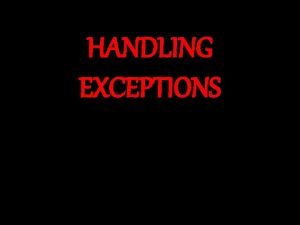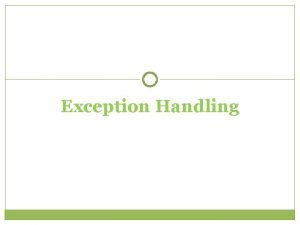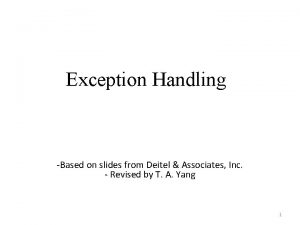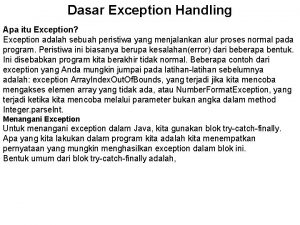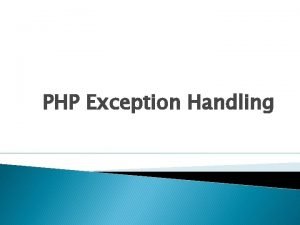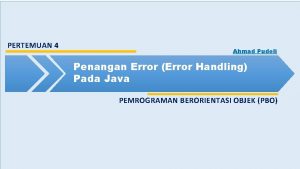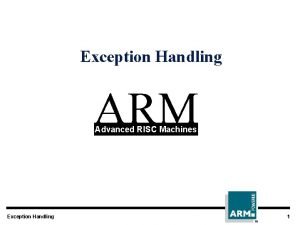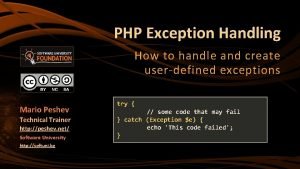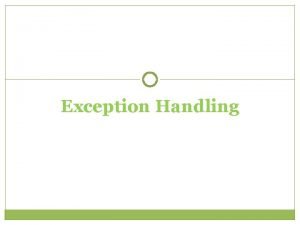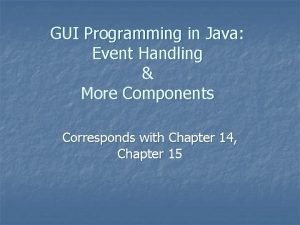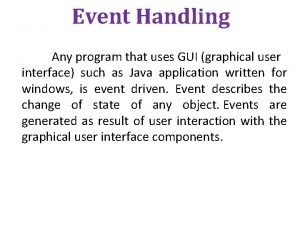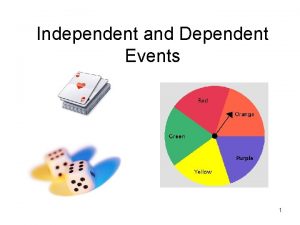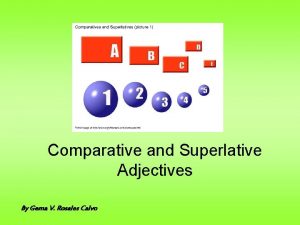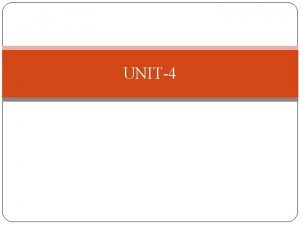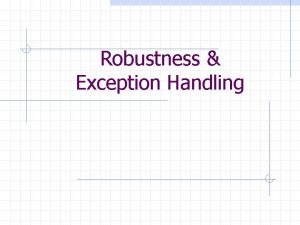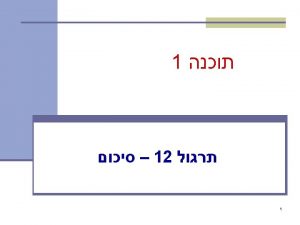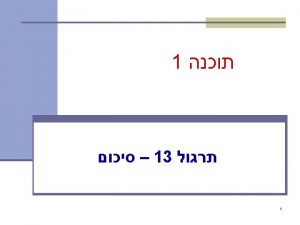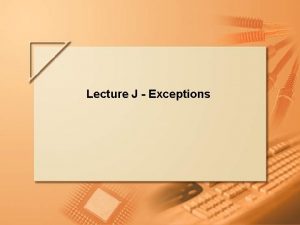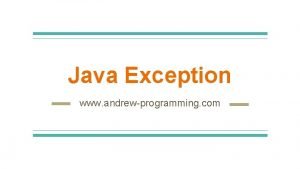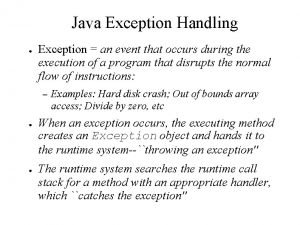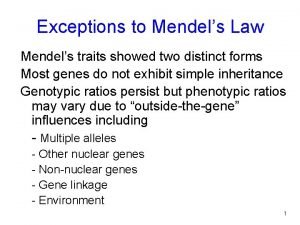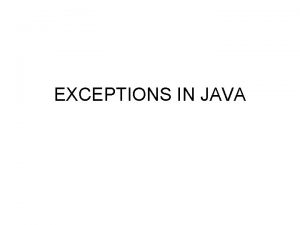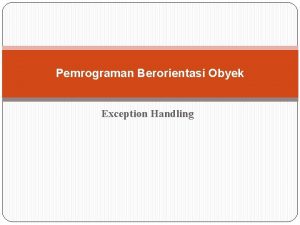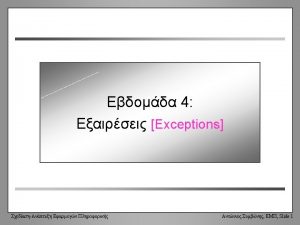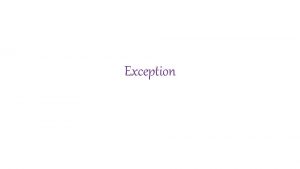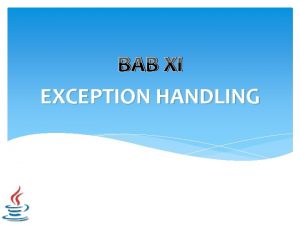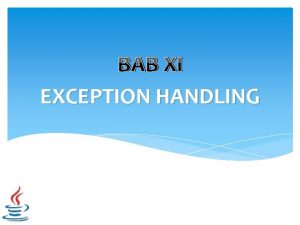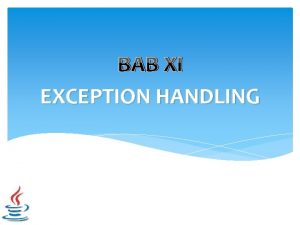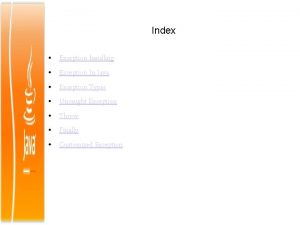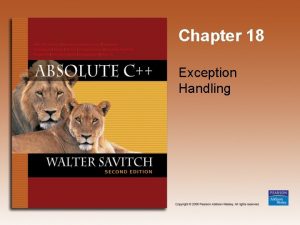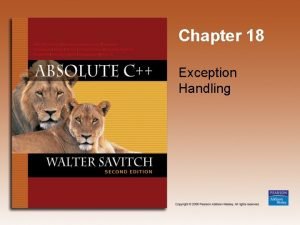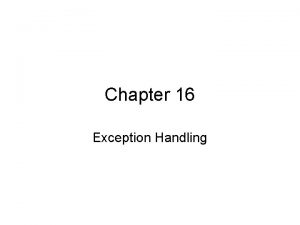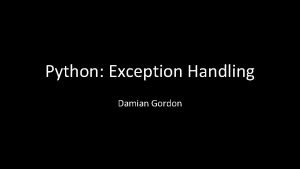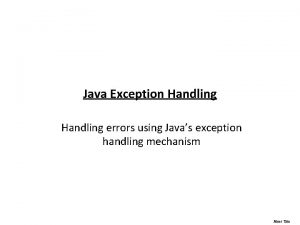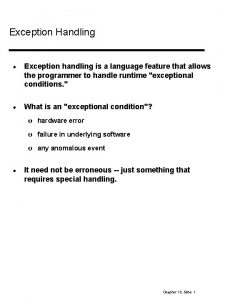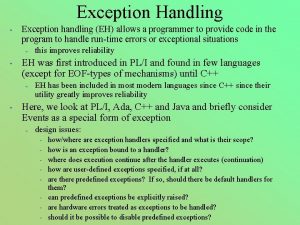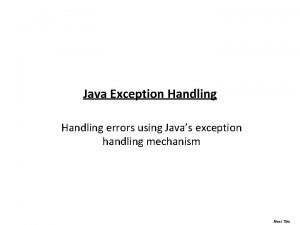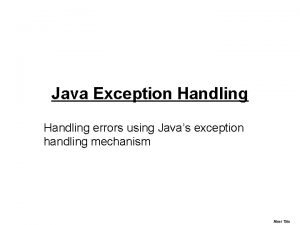Chapter 14 Exception Handling and Event Handling Chapter




















![Throwing Exceptions • All exceptions can be raised explicitly by the statement: throw [expression]; Throwing Exceptions • All exceptions can be raised explicitly by the statement: throw [expression];](https://slidetodoc.com/presentation_image/451c44221b0eac81f6c7deab050181f2/image-21.jpg)














- Slides: 35

Chapter 14 Exception Handling and Event Handling

Chapter 14 Topics Introduction to Exception Handling in Ada Exception Handling in C++ Exception Handling in Java Introduction to Event Handling with Java

Introduction to Exception Handling In a language without exception handling When an exception occurs, control goes to the operating system, where a message is displayed and the program is terminated In a language with exception handling Programs are allowed to trap some exceptions, thereby providing the possibility of fixing the problem and continuing

Basic Concepts • Many languages allow programs to trap input/output errors (including EOF) • An exception is any unusual event, either erroneous or not, detectable by either hardware or software, that may require special processing • The special processing that may be required after detection of an exception is called exception handling • The exception handling code unit is called an exception handler

Exception Handling Alternatives • An exception is raised when its associated event occurs • A language that does not have exception handling capabilities can still define, detect, raise, and handle exceptions (user defined, software detected) • Alternatives: – Send an auxiliary parameter or use the return value to indicate the return status of a subprogram – Pass a label parameter to all subprograms (error return is to the passed label) – Pass an exception handling subprogram to all subprograms

Advantages of Built-in Exception Handling • Error detection code is tedious to write and it clutters the program • Exception propagation allows a high level of reuse of exception handling code

Exception Handling Design Issues • How and where are exception handlers specified, and what is their scope? • How is an exception occurrence bound to an exception handler? • Where does execution continue, if at all, after an exception handler completes its execution? • How are user-defined exceptions specified? • Should there be default exception handlers for programs that do not provide their own? • Can built-in exceptions be explicitly raised? • Are hardware-detectable errors treated as exceptions that can be handled? • Are there any built-in exceptions? • How can exceptions be disabled, if at all?

Exception Handling Control Flow

Exception Safety A piece of code is said to be exception-safe if run-time failures within the code can not produce ill-effects. Levels of exception safety: – failure transparency – commit or rollback semantics – basic exception safety – minimal exception safety – no exception safety

Exception Safety Failure Transparency (BEST) – operations guaranteed to succeed Commit/Rollback Semantics – operations can fail – failures can not cause side effects Basic Exception Safety – failures can cause side effects – invariants on the state are preserved – failures can not store invalid data Minimal Exception Safety – failures can store invalid data – failures will not cause a crash No Exception Safety (WORST) – no guarantees

Exception Handling in Ada • An exception handler in Ada can occur in either a subprogram body, a package body, a task, or a block • Because exception handlers are usually local to the code in which the exception can be raised, they do not have parameters

Ada Exception Handlers • Handler form: when exception_choice{|exception_choice} => statement_sequence • Form of exception_choice : exception_name | others • Handlers are placed at the end of the block or unit in which they occur

Binding Exceptions to Handlers If the block or unit in which an exception is raised does not have a handler for that exception, then the exception is propagated elsewhere to be handled Procedures - propagate it to the caller Blocks - propagate it to the scope in which it appears Package body - propagate it to the declaration part of the unit that declared the package (if it is a library unit, the program is terminated) Task - no propagation; if it has a handler, execute it; in either case, mark it "completed"

Continuation The block or unit that raises an exception, but does not handle it, is always terminated Any block or unit to which an exception is propagated that does not handle it, is always terminated

Other Design Choices • User-defined Exceptions form: exception_name_list : exception; • Raising Exceptions form: raise [exception_name] – (the exception name is not required if it is in a handler--in this case, it propagates the same exception) • Exception conditions can be disabled with: pragma SUPPRESS(exception_list)

Predefined Exceptions CONSTRAINT_ERROR - index constraints, range constraints, etc. NUMERIC_ERROR - numeric operation cannot return a correct value (overflow, division by zero, etc. ) PROGRAM_ERROR - call to a subprogram whose body has not been elaborated STORAGE_ERROR - system runs out of heap TASKING_ERROR - an error associated with tasks

Evaluation • The Ada design for exception handling embodies the state-of-the-art in language design in 1980 • A significant advance over PL/I • Ada was the only widely used language with exception handling until it was added to C++

Exception Handling in C++ • Added to C++ in 1990 • Design is based on that of CLU, Ada, and ML

C++ Exception Handlers Syntax try { - code that might raise an exception } catch (formal parameter) { - handler code }. . . catch (formal parameter) { - handler code }

The catch Function • catch is the name of all handlers--it is an overloaded name, so the formal parameter of each must be unique • The formal parameter need not have a variable – It can be simply a type name to distinguish the handler it is in from others • The formal parameter can be used to transfer information to the handler • The formal parameter can be an ellipsis, in which case it handles all exceptions not yet handled
![Throwing Exceptions All exceptions can be raised explicitly by the statement throw expression Throwing Exceptions • All exceptions can be raised explicitly by the statement: throw [expression];](https://slidetodoc.com/presentation_image/451c44221b0eac81f6c7deab050181f2/image-21.jpg)
Throwing Exceptions • All exceptions can be raised explicitly by the statement: throw [expression]; • The brackets are metasymbols • A throw without an operand can only appear in a handler; – when it appears, it simply re-raises the exception, which is then handled elsewhere • The type of the expression disambiguates the intended handler

Unhandled Exceptions • An unhandled exception is propagated to the caller of the function in which it is raised • This propagation continues to the main function • If no handler is found, the program is terminated

Continuation • After a handler completes its execution, control flows to the first statement after the last handler in the sequence of handlers of which it is an element • Other design choices – All exceptions are user-defined – Exceptions are neither specified nor declared – Functions can list the exceptions they may raise – Without a specification, a function can raise any exception (the throw clause)

Evaluation • It is odd that exceptions are not named and that hardware- and system softwaredetectable exceptions cannot be handled • Binding exceptions to handlers through the type of the parameter does not help readability

Exception Handling in Java • Based on that of C++, but more in line with OOP philosophy • All exceptions are objects of classes that are descendants of the Throwable class

Classes of Exceptions The Java library includes two subclasses of Throwable : Error • Thrown by the Java interpreter for events such as heap overflow • Never handled by user programs Exception • User-defined exceptions are usually subclasses of this • Has two predefined subclasses – IOException – Runtime. Exception • Array. Index. Out. Of. Bounds. Exception • Null. Pointer. Exception • et cetera

Java Exception Handlers • Like those of C++, except every catch requires a named parameter and all parameters must be descendants of Throwable • Syntax of try clause is exactly that of C++ • Exceptions are thrown with throw, as in C++, but often the throw includes the new operator to create the object, as in: throw new My. Exception();

Binding Exceptions to Handlers • Binding an exception to a handler is simpler in Java than it is in C++ – An exception is bound to the first handler with a parameter is the same class as the thrown object or an ancestor of it • An exception can be handled and rethrown by including a throw in the handler (a handler could also throw a different exception)

Continuation • If no handler is found – in the try construct, the search is continued in the nearest enclosing try construct, etc. – in the method, the exception is propagated to the method’s caller – (all the way to main), the program is terminated • To insure that all exceptions are caught, a handler can be included in any try construct that catches all exceptions – Simply use an Exception class parameter – It must be the last in the try construct

Checked Exceptions and Unchecked Exceptions • The Java throws clause is quite different from the throw clause of C++ • Exceptions of class Error and Run. Time. Exception and all of their descendants are called unchecked exceptions • All other exceptions are called checked exceptions • Checked exceptions that may be thrown by a method must be either: – Listed in the throws clause, or – Handled in the method

Other Design Choices • A method cannot declare more exceptions in its throws clause than the method it overrides • A method that calls a method that lists a particular checked exception in its throws clause has three alternatives for dealing with that exception: – Catch and handle the exception – Catch the exception and throw an exception that is listed in its own throws clause – Declare it in its throws clause and do not handle it

The finally Clause • Can appear at the end of a try construct • Form: finally {. . . } • Purpose: To specify code that is to be executed, regardless of what happens in the try construct

Example A try construct with a finally clause can be used outside exception handling try { for (index = 0; index < 100; index++) { … if (…) { return; } //** end of if } //** end of for, end of try clause finally { … } //** end of try construct

Assertions • Statements in the program declaring a boolean expression regarding the current state of the computation – When evaluated to true nothing happens – When evaluated to false an Assertion. Error exception is thrown • Can be disabled during runtime without program modification or recompilation • Two forms – assert condition; – assert condition : [expression];

Evaluation • The types of exceptions makes more sense than in the case of C++ • The throws clause is better than that of C++ (The throw clause in C++ says little to the programmer) • The finally clause is often useful • The Java interpreter throws a variety of exceptions that can be handled by user programs
 Exception handling pl/sql
Exception handling pl/sql Exception handling in vb
Exception handling in vb Exception handling in java
Exception handling in java Dasar exception
Dasar exception Exception handler php
Exception handler php Exception handling pada java
Exception handling pada java Arm exception handling
Arm exception handling Exception handling in ada
Exception handling in ada Php exception
Php exception Exception handling in vb net
Exception handling in vb net Simple and compound events examples
Simple and compound events examples Java event handler example
Java event handler example Event handling in android
Event handling in android Java gui event handling
Java gui event handling Swing layouts
Swing layouts A sentinel event
A sentinel event Independent event vs dependent event
Independent event vs dependent event Independent and dependent probability
Independent and dependent probability Describe table of contents
Describe table of contents Newsworthy event background event source
Newsworthy event background event source Language features of news item text
Language features of news item text Charting by exception pros and cons
Charting by exception pros and cons Comparative form of important
Comparative form of important Hierarchy of thread class in java
Hierarchy of thread class in java Innerexception: system.io.directorynotfoundexception
Innerexception: system.io.directorynotfoundexception Apa itu robustness
Apa itu robustness Interface foo int k=0
Interface foo int k=0 Class a void foo() throws exception
Class a void foo() throws exception Unt concur
Unt concur Coccus
Coccus Runtimeexception extends exception
Runtimeexception extends exception What is exception
What is exception Exception vs error in java
Exception vs error in java Exception to mendel's laws
Exception to mendel's laws Exception class hierarchy in java
Exception class hierarchy in java Exception of koch postulates
Exception of koch postulates
